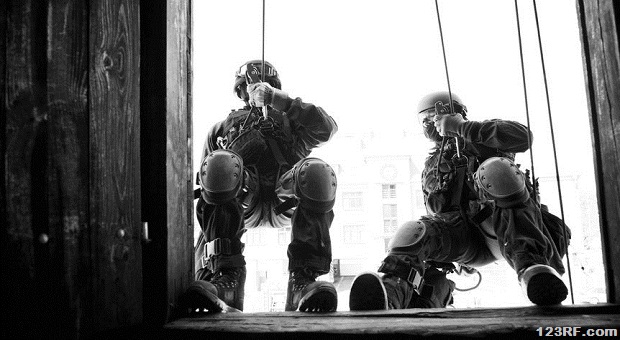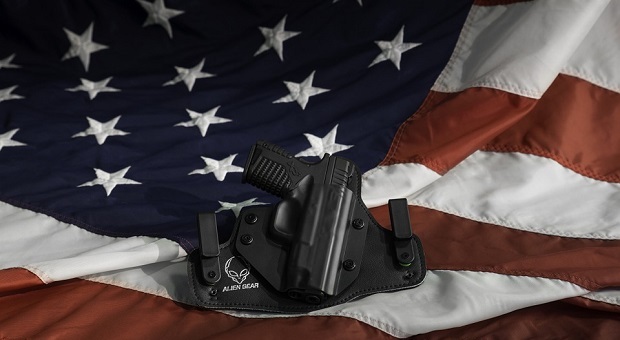In a time after a major crisis, knowing more about police foot patrolling and tactical techniques can help you remain safe and avoid problems. This includes knowing how to communicate with others about what you discover and what your plans are.
You will also need to know how to check secured doors or abandoned buildings quickly, quietly, and safely without incident or injuries.
How to Communicate Within the Group in Order to Coordinate Actions
There are 3 basic ways to communicate in your survival group:
Hand Signals
These are useful if light and distance allow them to be seen by others. You should create unique signals for your group so that no one else can understand what is being said. Hand signals work best in slow and stealthy operations. Signals should be designed so only the weak hand does the signaling and your strong hand controls your weapon.
Radios
When using a headset with the radio, use one that does not interfere or block the shooter from aiming and shooting a weapon.When using a headset the volume should be set so the radio traffic does not drown out the sounds around you. If you are not accustomed to filtering out sounds, it is best to practice now so that you will not wind up confused and frustrated in a situation.
When using radios always have a backup plan. Murphy’s Law dictates that when they are needed the most radios can fail and let you down. Having a runner messenger system may be used to communicate with a remote group or get information to others actually in the situation, but cannot see hand signals.
Verbal Commands
Verbal commands should be kept to between 10 to 20 words and should be short and to the point. Restrict talking to that which directly affects the job at hand. When you speak use a commanding voice if you need to clear rooms fast or get people to submit quickly.
Standard Verbal Commands and Replies
Whether you are clearing a room or a building there are certain words or short phases that must be used as simple orders or replies. The less said the better in this high tension environment. Below are a few commands and replies that might be helpful to a survival team clearing a building.
- Status- Command given by team leader to know if area is clear and ready to move on.
- Clear – Individuals reporting the area free from action or unoccupied.
- Room clear- Report that room is secure and safe.
- Coming out- Signal by team or individual that they are about to leave a room.
- Come out- Reply that room safe to enter.
- Coming in- Signal by person ready to enter an occupied room.
- Come in- Reply that room is safe to enter.
- Coming up or down- Signal by team about to ascend or descend a stairway.
- Come up or down- Reply that it is safe to ascend or descend a stairway.
- Man down- Signal when a team member is wounded or injured.
- Go long- Command given by 1 team member to another to move further down the hall or room.
- Stoppage- Signal when a team member’s weapon has malfunctioned or is being reloaded.
- Ready- Signal that team member’s weapon is fixed and he is ready to go.
- Stack up- A command to get ready to enter the next room or area.
- Dominate- Command for the team to take a controlling position in the room.
How to Check and Secure An Area When Looking for Shelter
{adinserter bph}It does not matter if your bug-out party is hiking or riding to the final destination.
There are times when the group must stop for an overnight rest or possibly longer. Here is a simple and safe way to check out and area to keep the party from getting ambushed, robbed, or murdered for the supplies and equipment that the group is carrying.
Scout Out the Area
Send out the group scouts to the new camp area. They will be checking for any human activity in the area. The scouts will be the eyes and ears of the group. These individuals must have an excellent knowledge of how to walk and travel in the wilderness without being noticed, heard, or found. If the area is determined to be safe then notify the group to begin quietly setting up an outer perimeter.
Setting Up an Outer Perimeter
The outer perimeter should have the purposed camp site encircled out to about 100 yards with all the out buildings, main buildings, and abandoned vehicles within the circle.
With the outer perimeter in place and sentries manning the perimeter the search teams will use the lay of the land for cover to begin a closer search of the interior of the perimeter for booby traps, hidden tunnels, or other signs of danger.
Check all Vehicles and Out Buildings
When checking all vehicles and out buildings consider them to be occupied and dangerous until proven otherwise. Start with the vehicle or out building nearest to the perimeter and working to the main building.
To check a vehicle, the team keeps the vehicle under observation with weapons at the ready. At this time the designated searcher moves forward in the vehicle’s blind spot and stays close to the vehicle for cover.
With quick glances into the vehicle’s interior the searcher checks to see if the vehicle is occupied, or if it has been lately. Check under the hood, in the trunk, and under the vehicle, then move to the next area to be searched.
To search one room out buildings begin with the search team taking the advantage of cover. If the out building has windows, have one member of the team work his way to the windows; and with fast glances check the interior of the building. Remember, the checker should always be in sight of at least 2 members of the team.
If no activity is noted, then a physical check of the building will still be needed. With the search team covering the out building, 2 members of the team quickly and carefully enter the building one at a time.
These team members should check the room for occupants either in open sight or hiding in ambush. If the building is not occupied then call out clear followed by the phase coming out.
How to Do a Quick Entry and a Room to Room Search In the Main Building
Before entering the main building, study the lay out for number of doors, windows, and floors to the structure. If it is a single floor structure, there will only be a few rooms to check and clear. If it is a multi-story building, then twice as much care is need to check and clear the building due to people hiding in the upper floor, sub-floors, basement and attic.
With all doors and windows covered, the entry team enters the building through the designated doorway one at a time. Moving through the room, the team checks all closets and other storage places for occupants and dangerous items used as booby traps.
As each room is checked and cleared you communicate with the team as needed. If there is a second floor, attic, or basement then each floor or section must be checked and cleared. Never drop your guard even though the the complete area of abandoned vehicles and outer buildings are clear.
What to Do After the Area is Secured
Now that your bug out group is in control of the area, it is time to set up guard posts and observation points that command and control the area. They can be as simple as fox holes dug along the perimeter.
The use of simple alarms like a tripwire tied to a can of rocks to alert the guards works very well. The final job is making sure everyone knows what their job is according to the duty roster.
How to Recognize a Dangerous or Suspicious Person
The following are a few ways that I have used in the past to help me recognize a dangerous or suspicious person.
- You feel like you are being followed or stalked. Go to a well-lit place, an open business, or merge with a group of people. Criminals do not want witnesses around.
- Look at the age group in the area that you are in. Are there more individuals under 30 years old or less? Most violent crimes are committed by men under 30 years old. If so start being aware of the people that are around you.
- Loitering by younger individuals who are standing against a building or lamp post with no obvious reason should be regarded as suspicious. Keep your guard up and take the appropriate action if needed.
- Individuals wearing loose or baggy clothing. The gangster look has become a very large fashion fad along with gang colors. It is very easy to hide a gun, knife, or other weapon in their clothing. Look at their body language. Are they just some people hanging out or are they thinking of you as a victim?
- Secretive behavior when an individual keeps looking around very nervously as if they do not want to be spotted. A person that is about to commit a crime may act nervous, jumpy, or paranoid. Get clear of this area or you may be his next victim.
- Men that have face and neck tattoos are openly advertising their tough and menacing behavior. Read his body language to see what his actions might be. If hostile take the appropriate action.
- If a person wears concealing headgear like larger hats, beanies, or hoodies that hide the face in good weather, it is a sign of possible criminal intent. This individual does not want to be identified and this helps to hide their true identity. It should be noted that some cultural types of clothing cover the face and head, yet the person in question may not be planning on committing a crime. Do not rely on head gear alone or clothing when determining if the person is “dangerous”.
- People with angry eyes, or are showing anger and aggression. Reading this look can show you danger. Take appropriate action and get clear of this individual.
- Wearing sunglasses at night is one way that criminals try to hide their identification at night. Read the individuals body language if there is a possible threat then take the appropriate action.
- When you are out and about listen to that little voice in your head telling you something is wrong. Usually something is very wrong. Some people call it a 6th sense, but use it for spotting criminals or areas that are attractive to criminals. This feeling could save your life.
In a time after a major crisis the use of simple police patrolling technics can can be a life saver. It can teach an individual how to check out an area safely without danger or injuries. Knowing how to read people and listening to your 6th sense could also be a life saver.
This article has been written by Fred Tyrell for Survivopedia.
























































































Situational awareness. Situational awareness. Situational awareness.
I am a reserve officer with my county Sheriff’s office. I don’t ride as often as I would like, but the key for anyone is situational awareness. Be in condition yellow all the time.
If you are not sure what I mean by this (to those that read this response), check out Col. Jeff Cooper’s color codes of situational awareness.
God bless and be safe!
Asle in medicine and several other professions, one must carefully note not just what the person speaking says to you but what they truly mean … all while being afraid to be really candid.
One additional voice communication is “Reload?” or “Reloading!” The first is if you know that your round count is low. The second is if your round count is nil, or if your partner has acknowledged your request to reload and has indicated his/her willingness to cover. You don’t want both in a fire team to be down at the same time.
When checking cars, it is much more likely that people will be in the passenger compartment than the trunk. HOWEVER, never walk passed the trunk without trying to raise the lid. If it’s an ambush, the lid may be unlocked. (This is particularly true of older cares. Some of the new ones, have trunk releases on the inside.) As noted above, situational awareness is the key.
Another note, remember this is about survival. If you don’t have to, don’t try to clear a house (except as an exercise). Leave it to the professionals who have Vests, Communication, the means (and willingness) to blow doors, flashbangs, etc. A Special Operation Team will probably have a minimum of 8 to 10 people. You probably have one or two on overlook. A stack should be at least five people– one to blow the door, one to the right, one cover the middle, one to the left, a rear guard. (The breacher might become the rear guard if short handed.) That’s just to get into the house. Once in, you clear the first room. Then there may be stairs and hallways that need to be covered, while a new stack is formed to clear the rooms off the entry area. I’ve cleared buildings with only a patrol partner. A little bag of wedges helps because all doors can be left open or sealed closed (like closets (better to clear them, but a wedge to keep the door from being opened provides safety when you only have a couple of guys.) Another skill that needs to be known (it is easy to learn and should be automatic) is to know which way a door opens by looking at the hinges (or lack there of.)
What professionals? We’re talking about when professionals are not available or maybe against you.
I just wanted to comment on two things. #1 this pretty much coincides with one of the best books out there called “Nine Meals To Anarchy” by Farrell Kingsley. The best book on this subject by the way. He talks about concealment and using ‘Force Multipliers’ such as night vision for clearing rooms and perimeters. Secondly I took a class from Andy Odom in Boise Idaho on learning how to do this in real life. He runs a company at the website idahofirearmsclasses.com and can teach these things in real life. I took his class in Portland Oregon and loved it. I learned so much.
Try not to use the word “GO” instead say “Move and Moving” saying the word “GO” can be perceived as “NO”…. Also using the word “Stoppage” can be perceived as “Stop” instead of “Stoppage” use terms like “Weapon Down” and “Weapon Up” try and keep it simple. Proper communication is key, a missed perceived command by a team member can lead to a very bad day. If you can be quiet then be quiet, if the fight is on then project your voice clearly and loudly if it calls for it.